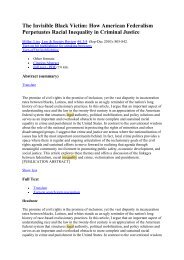Ski – resort and regional development: profile of visitors ... - E-Journal
Ski – resort and regional development: profile of visitors ... - E-Journal
Ski – resort and regional development: profile of visitors ... - E-Journal
Create successful ePaper yourself
Turn your PDF publications into a flip-book with our unique Google optimized e-Paper software.
The carrying capacity <strong>of</strong> mountainous tourist areas: the case <strong>of</strong> plastira’s lake<br />
noticed throughout the whole year with a percentage <strong>of</strong> about 18% in the month <strong>of</strong> August,<br />
whereas the average time <strong>of</strong> staying <strong>of</strong> the <strong>visitors</strong> was 2.0 days for locals <strong>and</strong> approximately<br />
1.5 for foreign <strong>visitors</strong> (GTO, 2003).<br />
THE TOURISM CARRYING CAPACITY OF AN AREA<br />
The large increase <strong>of</strong> dem<strong>and</strong> for recreation internationally as well as in Greece over the last<br />
decades has caused the administrators’ concerns regarding the extents <strong>of</strong> recreation, due to<br />
pro<strong>of</strong>s that the recreation activities downgrade the natural environment. Moreover, the increased<br />
dem<strong>and</strong> <strong>of</strong> recreation has as a result the reduction <strong>of</strong> the <strong>visitors</strong>’ satisfaction. Consequently,<br />
the information <strong>of</strong> taking the suitable measures is necessary to avoid these problems. This<br />
kind <strong>of</strong> information is related to the idea (concept) <strong>of</strong> carrying capacity which is the connection<br />
between supply <strong>and</strong> dem<strong>and</strong> <strong>of</strong> recreation. The idea <strong>of</strong> capacity is very important in the<br />
management <strong>of</strong> natural resources, while its origin is biological <strong>and</strong> has been connected closely<br />
with the idea (concept) <strong>of</strong> sustainability.<br />
In the recreation sector the significance <strong>of</strong> carrying capacity began to be taken into consideration<br />
mainly after the 1960s. In 1960, in the outdoor recreation plan <strong>of</strong> California it was placed as<br />
one <strong>of</strong> its basic hypothesis that each natural area <strong>of</strong> recreation has the maximum capacity<br />
(number <strong>of</strong> individuals in the unit <strong>of</strong> surface per day <strong>and</strong> season). When the area is used<br />
beyond its capacity, the character <strong>and</strong> the quality <strong>of</strong> natural resources changes, is downgraded<br />
or destroyed.<br />
The main approaches <strong>of</strong> carrying capacity are: ecological, social or psychological or aesthetics,<br />
natural <strong>and</strong> economical (Trakolis, 2003). In the ecological approach it is defined as the ability<br />
<strong>of</strong> natural resources <strong>and</strong> ecosystems to support tourism <strong>development</strong>. In the social or<br />
psychological approach the <strong>visitors</strong>’ pleasure/enjoyment is used as measure/limit for the<br />
tourism <strong>development</strong> in a region, while in the economic it is used as the limit <strong>of</strong> equation <strong>of</strong><br />
marginal cost with the marginal pr<strong>of</strong>it that results from the tourism <strong>development</strong> for the area.<br />
The significance <strong>of</strong> tourism carrying capacity <strong>of</strong> an area is associated with (a) the ability <strong>of</strong><br />
a tourism destination to absorb the tourism <strong>development</strong> before the negative results become<br />
perceptible by the host community <strong>and</strong> (b) the level <strong>of</strong> tourism <strong>development</strong> beyond which<br />
the particular destination ceases to attract <strong>and</strong> to satisfy the tourists. Stankey (1981) <strong>and</strong> Baud-<br />
Bovy (1977) report as tourism carrying capacity the number <strong>of</strong> periods <strong>of</strong> use that an area can<br />
<strong>of</strong>fer for recreation (each year) without causing permanent biological <strong>and</strong> natural destruction<br />
<strong>of</strong> the ability <strong>of</strong> the area to support recreation <strong>and</strong> without a significant weakening <strong>of</strong> the<br />
quality <strong>of</strong> the recreation experience.<br />
World Tourism Organization refers as carrying capacity <strong>of</strong> a tourist <strong>resort</strong>, "the maximum<br />
number <strong>of</strong> people that may visit a tourist destination at the same time, without causing<br />
destruction <strong>of</strong> the physical, economic <strong>and</strong> socio <strong>–</strong> cultural environment <strong>and</strong> an unacceptable<br />
decrease in the quality <strong>of</strong> the visitor’s satisfaction (WTO, 1981)".<br />
Tourism Today - Fall 2007 - Full Paper<br />
111














